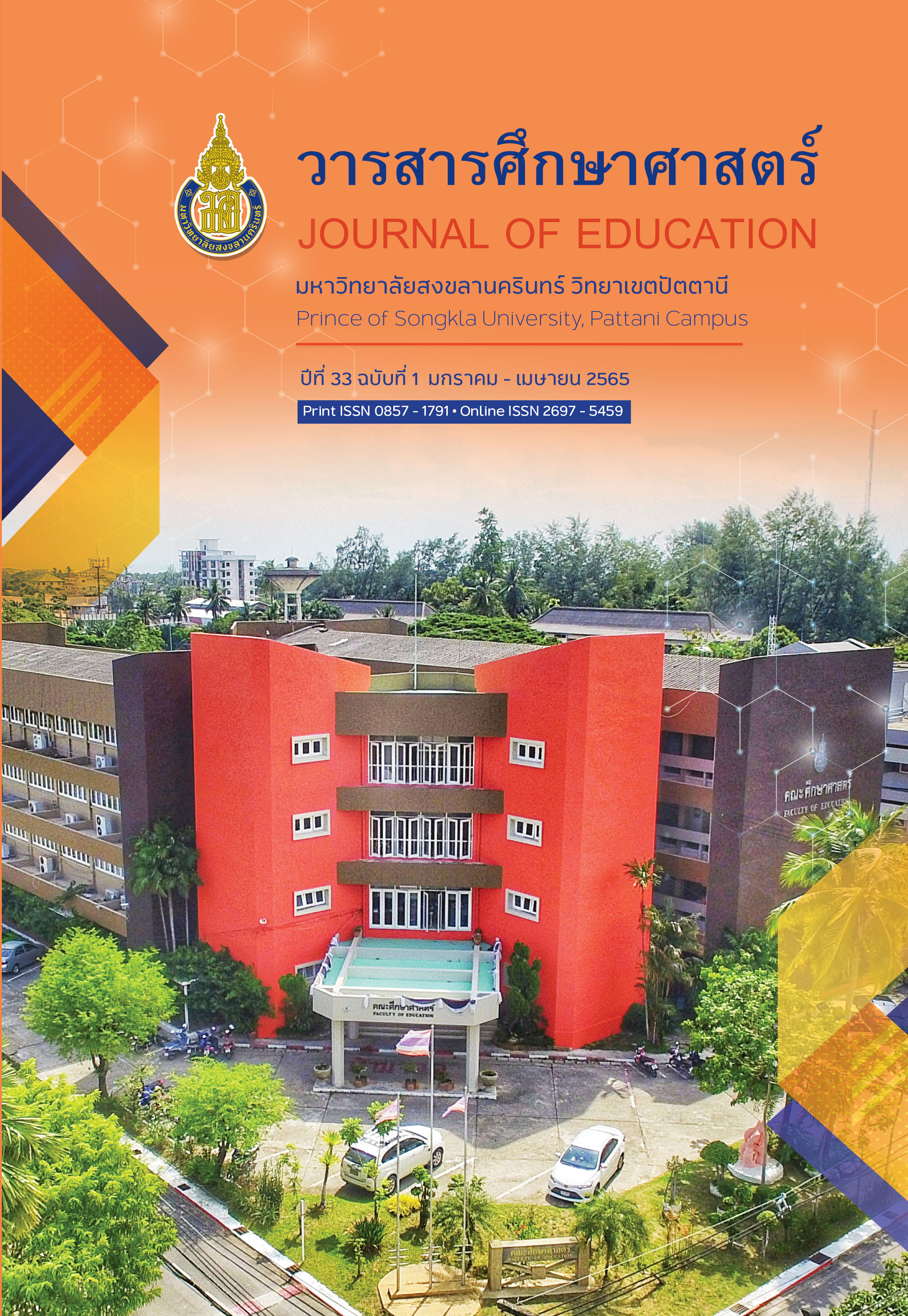ผลการจัดการเรียนรู้ตามแนวพุทธวิธี ในรายวิชาสัจธรรมนำชีวิตสำหรับครู เพื่อการพัฒนาทักษะการทำงานเป็นทีมสำหรับนิสิตปริญญาตรี
Main Article Content
บทคัดย่อ
การวิจัยครั้งนี้มีวัตถุประสงค์เพื่อ 1) ออกแบบการจัดการเรียนรู้ตามแนวพุทธวิธี และ 2) ศึกษาผลการจัดการเรียนรู้ตามแนวพุทธวิธี การวิจัยในครั้งนี้เป็นการวิจัยทดลองเบื้องต้นโดยใช้รูปแบบ One –Shot Case Study กลุ่มเป้าหมายในการวิจัยเป็นนิสิตปริญญาตรี ทุกคณะทุกชั้นปี มหาวิทยาลัยทักษิณ ที่ลงทะเบียนเรียนในรายวิชาสัจธรรมนำชีวิตสำหรับครู ในภาคการศึกษาปลาย ปีการศึกษา 2562 จำนวน 55 คน เครื่องมือที่ใช้ในการวิจัยประกอบด้วย แผนการจัดการเรียนรู้ตามแนวพุทธวิธี แบบทดสอบวัดผลสัมฤทธิ์ทางการเรียน แบบวัดทักษะการทำงานเป็นทีม และแบบสอบถามความพึงพอใจ วิเคราะห์ข้อมูลโดยใช้สถิติพื้นฐาน คือ ร้อยละ ค่าเฉลี่ย และส่วนเบี่ยงเบนมาตรฐาน
ผลการวิจัยพบว่า 1) การจัดการเรียนรู้ตามแนวพุทธวิธี ประกอบด้วยแผนการจัดการเรียนรู้ จำนวน 4 แผน 16 สัปดาห์ เวลา 64 ชั่วโมง ดำเนินการจัดกิจกรรมการเรียนรู้ใน 5 ขั้นตอน คือ ขั้นที่ 1 การตระหนักถึงคุณค่าของศาสนาที่ผู้เรียนนับถือ ขั้นที่ 2 การค้นคว้าหาสาเหตุที่เกิดขึ้น ขั้นที่ 3 การตั้งสมมติฐาน ขั้นที่ 4 การวิเคราะห์ข้อมูล ขั้นที่ 5 การประเมินผลการเรียนรู้ 2) ผลการจัดการเรียนรู้ตามแนวพุทธวิธี พบว่า ด้านผลสัมฤทธิ์ทางการเรียน โดยนิสิตร้อยละ 75 มีคะแนนผ่านเกณฑ์ร้อยละ 75 ขึ้นไป ผลการวิจัยพบว่า มีนิสิตที่ผ่านเกณฑ์จำนวน 45 คนคิดเป็นร้อยละ 81.81 และมีคะแนนเฉลี่ย 30.42 คิดเป็นร้อยละ 76.05 ซึ่งสูงกว่าเกณฑ์ที่กำหนดไว้ ผลการเรียนรู้ของนิสิตด้านทักษะการทำงานเป็นทีม ในภาพรวมอยู่ในระดับดีมาก (= 3.58, S.D. = 0.34) และผลการศึกษาความพึงพอใจของนิสิตต่อการจัดกิจกรรมการเรียนรู้ พบว่า นิสิตมีความพึงพอใจในภาพรวมอยู่ในระดับมากที่สุด (
= 4.54, S.D. = 0.41)
Article Details

อนุญาตภายใต้เงื่อนไข Creative Commons Attribution-NonCommercial 4.0 International License.
เอกสารอ้างอิง
Achito, P. (2017). Model Buddhist Learning in The 21st Century. Journal of Yanasangvorn Research Institute, 8(2), 309-318. [in Thai]
Anderson, L. W., & Krathwohl, D. R. (2001). A taxonomy for learning, teaching, and assessing: A revision of Bloom’s taxonomy of educational objectives. New York: Addison Wesley Longman.
ChantapaMojcho, P. (2020). The application of the threefold training (tisakkha) for promotion of learning of high school students of lamplaimas school in lamplaimas sub-district, lamplaimas district, buriram province. Wanamduang Journal of Buddhist Studies,
(1), 1-14. [in Thai]
David, R. S. (1996). Developmental Psychology Childhood and Adolescence. (4th ed): Pacific Grove: Brook/Cole.
Gordon, H. & Ernest, R. H. (1981). Theories of Learning. Pretice - Hall Inc.
Intakul, S. & Phrakhruupakitpariyattisopon. (2021). Students' satisfaction with the learning and teaching of Mahachulalongkornrajavidyalaya University Uthai Thani College. Journal of Graduate Studies Periscope Nakhon Sawan Sangha College, 8(1), 163-180. [in Thai]
Johnson, D. W., & Johnson, F. D. (2003). Joining: Group Theory and Group Skill. (8th ed). Boston: Allyn and Bacon.
Jutapama, M. (2010). How important is self-esteem? And how to create? Academic journal Buriram Rajabhat University, 2(2), 13-14. [in Thai]
Katzenbach, J. R., & Smith, D. K. (1999). The Wisdom of Teams. New York: Harper Collins.
Keawchaoon, K. & Chuntuk, T. (2017). Team Working for Increasing Work Effectiveness. Dusit Thani College Journal, 11(1), 355-370. [in Thai]
Keawparadai, T. (2020). A Study of Relationship of 5 Balas and 4 Iddhiipadas. Innovative Journal of Educational Management and Research, 2(1), 31-38. [in Thai]
Kunaphon, P. (Por Payutto). (2007). Method of thinking according to Buddhist principles. Bangkok: Statute. [in Thai]
Kunaphon, P. (Por Payutto). (2009). Buddha dharma. (12th ed). Bangkok: Mahachulalongkorn rajavidyalaya Printing Press. [in Thai]
Meyers, C. & Jones, T. B. (1993). Promoting Active Learning: Strategies for the Collage Classroom. San Francisco: Jossey-Bass.
Neal, K. B., Amendola, N., Jeske, D. M., Martorana, R., Smith, E. G., Joyce, S. J., & Baudinette, S. (2018). International Journal of Teaching and Learning in Higher Education, 30(2), 334-349.
Nithichottikarn, C. (2022). Actors influencing team working in human resources development of hospital personnel in of Bangkok hospitals group. Journal of MCU Nakhondhat, 8(9), 266-280. [in Thai]
Office of the Council of State. (1999). Act/Royal Decree. Retrieved from https://person.mwit.ac.th/01-Statutes/NationalEducation.pdf. [in Thai]
Office of the Education Council Secretariat. (2017). National Education Plan 2017-2036. Bangkok: Prigwhan Graphic Co., Ltd. [in Thai]
Pidhokkosol, P. (2019). Sevenfold kalanamitta-dhamma in tipitaka for teachers. Journal of MCU Nakhondhat, 6(9), 4199-4214. [in Thai]
Promthong, T. & Trakarnsirinont, W. (2017). The Study of Citizenship: Case Study of People in Umong Subdistrict, Mueang District, Lamphun Province. Journal of Political Science and Public Administration, 8(2), 103-127. [in Thai]
Putsom, W. & Junbu, J. (2022). The Influence of Work Roles, Processes, and Work Motivation On Student TeamWork Efficiency. Academic Journal of the Association of Private Higher Education Institutions of Thailand (ETC), 27(1), 94-112. [in Thai]
Rajaparayattimuni, P., Sukhawatthano, P. & Ngamchat, P. (2021). Model Development of Buddhist Transformative Learning Process Management. Journal of Palisueksabuddhaghosa Review, 7(1), 1-11. [in Thai]
Robbins, S. P. (2001). Organization Bahavior. New Jerey, NJ: Prentice Hall.
Senge, P. M. and other. (1994). The Fifth Discipline Fieldbook. New York: Currency.
Sriphahon, S. (2009). Learning and teaching group, social studies, religion and Culture. Nonthaburi: Printing press, Sukhothai Thammathirat Open University. [in Thai]
Sukpom, T. (2014). The development of teaching and learning models according to Buddhist methods. to enhance graduate characteristics Desirable in terms of morality and ethics of students of Chandrakasem Rajabhat University. Kasem Bundit Journal,
(1), 56-74. [in Thai]
Sumetho, P., Thungnark, N. & Makemuengthong, C. (2019). The Development of Instructional Model according to Buddhist Principle to Improve Desirable Characteristics of Graduate on Moral and Ethic. Dhammathas Academic Journal, 19(2), 1-17. [in Thai]
Thi-Huyen, N., Xuan-Lam, P., Thanh T., & Nguyen T. (2021). Eurasian Journal of Educational Research, 30(2), 30-50.
UdornUttaro, P. (2017). The buddha’s teachings methodsin classroom to kalayanamitta dhammas. Journal of Yanasangvorn Research Institute, 8(2), 309-318. [in Thai]
Vathakaew, P., Ponsen, K. & Krongcheep, S. (2019). Study the satisfaction of graduate students towards dharma practice in theory and meditation practice (gs 2006) buddhism and philosophy program mahamakut buddhist university mahavajiralongkornrajavidyalaya campus. Journal of Nakhon Lampang Monastic College, 8(3), 47-57. [in Thai]
Wanchaithanawong, W. (2017). Development of awareness of life values for nursing students.journal Boromarajonani College of Nursing, Uttaradit, 9(2), 112-113. [in Thai]
Wisuttho, P. (2022). Buddhist methods of teaching social studies in the 21st century. Journal of Buddhist Education and Research : JBER, 7(2), 300-310. [in Thai]
Wongchalee, S. (2017). An Application of Buddhist Philosophy Four Noble Truths in to the Course Syllabus of Social Studies Teachers in Srisaket Primary Educational Service Area Office 3. Thammasat Academic Journal, 17(1), 135-146. [in Thai]


